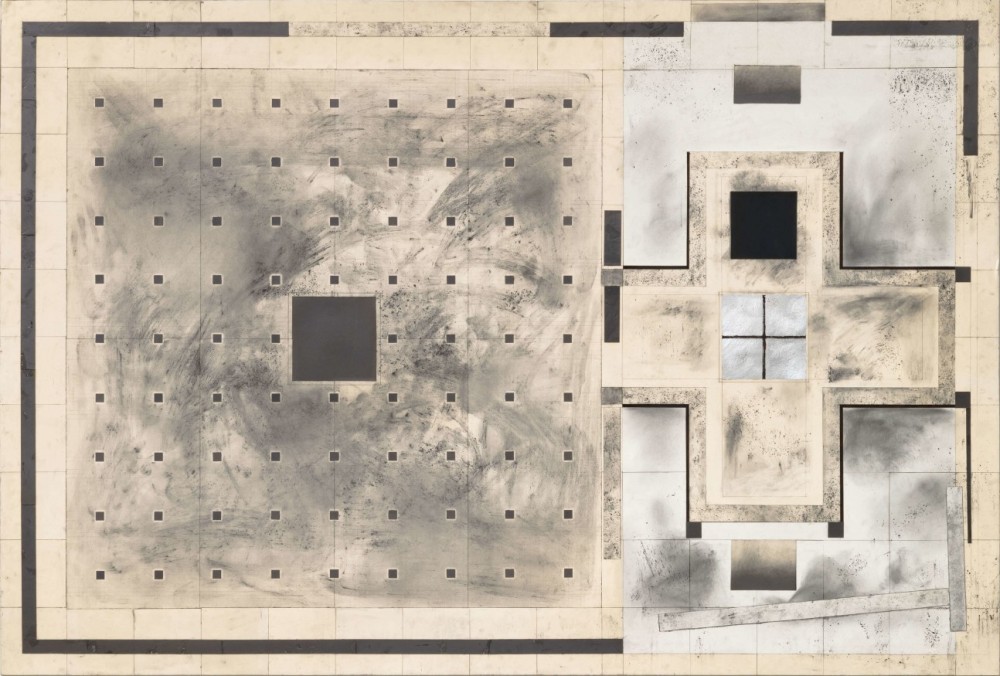
MICHELLE STUART: Reflections on Paradise
This exhibition features a selection of works on paper inspired by riads, traditional Moroccan interior gardens that Stuart encountered on her travels to Zagora and Marrakech. Largely comprised of richly applied graphite shapes, these drawings carefully interconnect subtle elements of watercolor, silver pencil, collaged paper, and silver leaf to form what Stuart describes as “imagined places of serenity.” Rendering her architectural forms in overhead perspective, Stuart echoes complex patterns in the elaborate tile work that often decorates the pools and fountains found in the gardens.
Stuart’s signature frottage technique is also present in many of these drawings and parallels the rubbing processes used in her large scale scroll works. In the riad drawings, the texture of the earth is often transferred to the paper surface, thus connecting these imaginary spaces to the materiality of the landscape itself.
Stuart’s long standing exploration of the minimalist grid is equally important in the riad works. A mapping tool that runs through her photographic installations, encaustic paintings and works on paper, Stuart’s grids delineate and divide the space within her works to organize her organic forms. In the riad drawings the grids function architecturally, providing a geometric framework for the artist’s fantastical spaces.
Recalling the journey to North Africa that inspired her riad drawings, Stuart writes;
In 1982 I traveled to Morocco to see traditional gardens, first with Berbers in Zagora, later in Marrakech to sketch the 12th century Almoravid palace. The spaces of village structures held architectural affinities. There was a feeling that they were built to enclose an open space, open to the sky, sun, stars, and moon.
These open cloisters surrounded a small square or rectangular pool. Nothing was in the water, except water. Conceived in this beautifully minimal way, it was no more or less than one needed to imagine. Sometimes there were orange or lemon trees. It was as though the desire for indoor /outdoor space was so intense that it had to be repeated. Maybe this dates back to the tent which was the original indoor space in the vast desert that could be taken and carried to another place--a square to be imagined in an outdoor space, the opposite of the open interior courtyard. The water offered the possibility of life as an oasis or a traditional Persian paradise garden. Protected in the open space, you could contemplate the cosmos reflected in the pool. Truly a paradise.
When I returned to my studio from North Africa, I began to imagine these spaces as my own—drawing them set me on my journey. I imagined glistening silver and graphite collages reflecting serenity, and contemplation, places where one’s imagination could enter the constellations of paradise.
Surrounded by the Riad drawings and installed across the gallery’s floor, Stuart’s sculpture, Starmarker, will be shown for the first time since it was exhibited at the Wanås Sculpture Park in Knislinge, Sweden in 1992. Starmarker consists of ten marble sculptures, each intended to represent an individual star within a constellation. For the artist’s current exhibition, the pyramids will be placed to map the constellation Boötes, which will be visible in the sky over Los Angeles.
Since the 1970s, Michelle Stuart has been internationally recognized for a rich and diverse practice, including site-specific earth works, intimate drawings, paintings, sculpture, and photographs, all centered on a lifelong interest in the natural world and the cosmos.
Stuart’s works have been acquired by an extraordinary number of public institutions in recent years including: The Hirshorn Museum, Washington D.C.; the Philadelphia Museum of Art; The Centre Pompidou, Paris; Museum of Modern Art, San Francisco; the Metropolitan Museum of Art, New York; the Chicago Art Institute; the Hammer Museum, Los Angeles; The Dia Art Foundation, New York; the Tate, London; Glenstone, Maryland; and The Rachofsky Collection in Dallas, among others.
Born in Los Angeles, Michelle Stuart lives and works in New York and California. Individual museum shows include: Place and Time, Walker Art Center, Minneapolis; Michelle Stuart, Theatre of Memory: Photographic Works at The Bronx Museum of the Arts, Bronx, N.Y, and Michelle Stuart: Drawn from Nature, which originated in 2013 at the Djanogly Art Center, Nottingham, UK and traveled to the Parrish Art Museum, Water Mill, NY, and the Santa Barbara Museum of Art, accompanied by a catalogue published by Hatje Cantz. Her work has also been the focus of solo exhibitions at the Centre d’Arts Plastiques Contemporaines de Bordeaux, France; the Institute of Contemporary Art, London; the Walker Art Center, Minneapolis; the Haags Gemeentemuseum, The Hague, and many other major museums and galleries worldwide. Stuart’s work was also presented in Viva Arte Viva!, curated by Christine Macel at the 57th Venice Biennale in 2017.